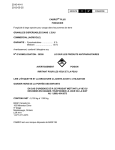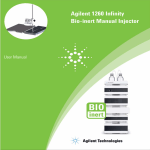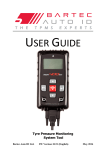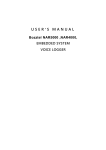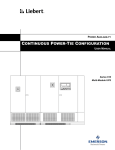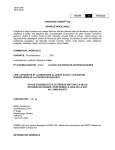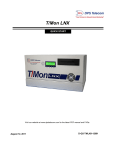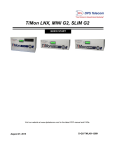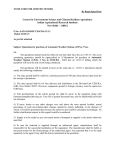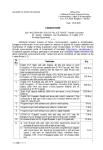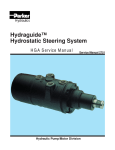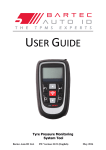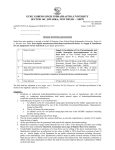Download By Regd - Indian Agricultural Research Institute
Transcript
By Regd. Post INDIAN AGRICUTURAL RESEARCH INSTITUTE NEW DELHI -110012 Dated : 12/10/2011 To Subject: Quotation for supply of Online UPS at IARI Sir, IARI invites sealed tender for supply of online UPS of minimum capacity of 20KVA. The quotation should reach this office by not later than 02:30 hrs. on 04/11/2011. The cover containing quotation should be superscribed as “Quotations for Online UPS” in the Unit of Simulation and Informatics, IARI due on 04/11/2011 failing which the quotation will have the risk of not being considered. The quotation will be opened at 03:00 on the same day i.e. 04/11/2011. Quotation shall satisfy the following conditions: 1. The rates quoted shall be valid for a minimum period of 180 days from the last date fixed for the receipt of quotations. 2. The rates quoted shall be for free delivery and installation at the Network Centre, USI, IARI, New Delhi – 110 012. However, equipment quoted in foreign currency must be quoted on FOB basis. 3. Full specifications of the article quoted for shall be given in the quotation along with literature/pamplet/drawing etc. User list of the quoted document may also be additionally provided for reference. 4. If taxes, duties or any other charges over and above the rates quoted leviable, actual percentage of such taxes/duties/other charges should be clearly indicated. 5. Supply is to be made by any convenient mode of transport at supplier’s risk unless otherwise specified. 6. In case the material is supplied through an authorized agent, manufacturer shall be responsible for the successful installation of the equipment. The manufacturer shall be liable to any penal action for the shortcomings of the authorized agent. Any payment that is to be made separately to the agent if any shall be clearly mentioned in the quotation. 7. The bid should be accompanied with earnest money of Rs. 50,000/- (Rupees Fifty thousand only) as mentioned against each of the equipment in the form D.D./Pay Order drawn in favour of Director, IARI, on any Nationalized Bank, without which the quotation will not be entertained. 8. The EMD shall be refunded to the unsuccessful bidders after finalization of the quotation. In case of successful bidder, it can be adjusted towards security deposit which is 10% of the order value for the equipment/goods costing Rs.5.00 lakhs or more. Here would however, be no performance security deposit for equipment/goods costing less than Rs. 5.00 lakhs. 9. One year warranty has to be invariable provided by the firm. 10. Payment will be made by mode of e-payment to the supplier/firm after satisfactory completion of work and receipt of pre-receipt bills triplicate. In case of foreign currency payment shall generally be made through LC directly to the manufacturer. 11 The Director IARI, New Delhi reserves the right to accept or reject any or all the quotations either in full or in parts without assigning any reason. 12. Quotations not complying with the above conditions are liable to rejected. 13. Sealed quotations should be put in the “quotation Box” of the USI, IARI, New Delhi 14. TIN/VAT/PAN/C.S.T. Nos may be given on the Quotation. 15. Sealed quotation should be submitted only in two bid systems (Technical and Financial). Technical and financial bids are to be prepared and placed in two different sealed envelopes after clearly writing technical and financial bid on top of the respective envelopes. These two sealed envelopes should then be placed in single sealed envelope and submitted to Head, Unit of Simulation and Informatics, LBS Building, IARI, New Delhi-110012 on or before the due date. Technical Specifications UPS with accessories Uninterrupted power supply units shall be designed on the latest technology with best in class components to provide reliable operation for continuous 7x24x365 days. The ups shall be true on-line double conversion UPS system using IGBT based technology i.e. the IGBT based Rectifier of the UPS system converts the input AC power to DC and then the IGBT based inverter converts the DC into clean AC power. UPS solution shall be N+1. SN Detailed Technical Specifications UPS (Uninterrupted Power Supply) with accessories 1 2 MakeModel - 3 System capacity- (Minimum capacity of 20 KVA) 32 KW N+1 4 Type of redundancy- N+1 5 Backup time- 1 Hour on Full load B GENERAL SPECIFICATIONS 1 This specification describes the operation and functionality of a continuous duty, three-phase, solid-state, on-line double conversion static Uninterruptible Power System (UPS) hereafter referred to as the UPS. The UPS shall utilize a rack-mounted N+1 redundant, scalable array architecture. Each ups modules contains a full rated input rectifier / boost converter (hereafter referred to as Input Converter), full rated output inverter (Kva =KW), and battery charging circuit. The system shall also comprise of a user-replaceable continuous duty bypass static switch module The system shall also comprise of a user-replaceable hot swappable battery modules, which can be swapped with out switching of the ups modules when required. The system shall also comprise of redundant main controller modules, redundant logic power supplies, which can be swapped with out switching off any ups modules when required. The UPS manufacturer should provide an output distribution system to distribute quality uninterrupted power for mission critical, data centre load. This distribution system should be installed in side the ups modules along with input, output & manual bypass switches in a metal enclosure which is in side UPS rack. Out put distribution should happen through 3phase & neutral bus-duct. The ups units & the batteries shall be scalable with out shutting down the mission critical Data Centre load. 2 3 4 5 6 7 Complie d, Yes/No Vender offering (Strictly need to specify ) C 1 D 1 2 MODES OF OPERATIONS A. Normal: The input converter and output inverter shall operate in an on-line manner to continuously regulate power to the critical load. The input and output converters shall be capable of full battery recharge while simultaneously providing regulated power to the load for all line and load conditions within the range of the UPS specifications. B. Battery: Upon failure of the AC input source, the critical load shall continue being supplied by the output inverter, which shall derive its power from the battery system. There shall be no interruption in power to the critical load during both transfers to battery operation and retransfers from battery to normal operation. C. Recharge: Upon restoration of the AC input source, the input converter and output inverter shall simultaneously recharge the battery and provide regulated power to the critical load. D. Static Bypass: The static bypass shall be used to provide controller transfer of critical load from the inverter output to the bypass source. This transfer, along with its retransfer, shall take place with no power interruption to the critical load. In the event of a UPS output fault or significant output overload emergency, this transfer shall be an automatic function. Manual transfer to Static Bypass (called “Requested bypass”) shall be available in order to facilitate a controlled transfer to Maintenance Bypass E. Maintenance Bypass: The system can be equipped with an optional integrated, bus connected external make-before-break Maintenance Bypass Cabinet to electrically isolate the UPS during routine maintenance and service of the UPS. The make-beforebreak Maintenance Bypass Cabinet shall allow for the completely electrical isolation of the UPS. An option for an external makebefore-break external maintenance bypass panel shall be available SYSTEM CHARACTERISTICS. System Capacity: The system shall be rated for full kW output. UPS Input A AC Input Nominal Voltage: 230 V, 3 Phase, 4 wire + G, 50 Hz. B C AC Input Voltage Window: 340 – 475VAC (while providing nominal charging to the battery system). Maximum Frequency Range: 40-70Hz D Input Power Factor: 2 3 4 5 a. Greater than 0.99 with load at 100% b. Greater than 0.99 with loads above 50% E Input Current Distortion: F Input current Distortion with no additional filters: less than 5% Soft-Start: Shall be linear from 0-100% input current and shall not exhibit inrush. This shall take place over a user selectable 1- 60 second time period with a factory default of 10 seconds. 3 A UPS OUTPUT. AC Output Nominal Output: 230V, 3 Phase, 4 wire + G, 50 Hz. B D AC Output Voltage Distortion: Less than. 2% @ 100% Linear Load. Less than 6% for SMPS load as defined by EN50091-3/IEC 62040-3. AC Output Voltage Regulation: +/- 1% For 100 % Linear or Nonlinear Load Voltage Transient Recovery within <50 milliseconds E Overload Rating : Normal Operation: C 1) 150% for 30 seconds before transfer to Bypass 2) 125% for 10 minutes before transfer to bypass F Overload Rating : Bypass operation 1) 125% continuous 2) 1000% for 500 milliseconds G System AC-AC Efficiency: H Normal operation > 96% at 40% - 100% load Battery operation > 96% at 40% to 100% load Output Power Factor Rating: 0.5 leading to 0.5 lagging without any derating Battery Protection: I 4 A B C 5 A B C The inverter shall be provided with monitoring and control circuits to limit the level of discharge on the battery system. CHARGING The battery charging shall keep the DC bus float voltage at +/-1% of tolerance The battery charging circuit shall contain a temperature compensation circuit, which will regulate the battery charging to optimize battery life. The battery charging circuit shall remain active when in Static Bypass and in Normal Operation BATTERIES The UPS battery shall support an optional battery plant of modular construction made up of user replaceable, hot swappable, fused, battery modules. Each battery module shall be monitored for voltage and temperature for use by the UPS battery diagnostic. Battery charging current shall be temperature compensated. The battery jars housed within each removable battery module shall be of the Valve Regulated Lead Acid (VRLA) type. The UPS shall incorporate a battery management system to continuously monitor the health of each removable battery module. This system shall notify the user in the event that a failed or weak battery module is found. D 6 A B C D 7 A B C D 8 A B C D The Batteries shall be long life batteries (5-8year) and the battery casing shall be flame retardant type. SOFTWARE AND CONNECTIVITY Network Adaptor: The Ethernet Web/SNMP Adaptor shall allow one or more network management systems (NMS) to monitor and manage the UPS in TCP/IP network environments. The management information base (MIB) shall be provided in DOS and UNIX "tar" formats. Unattended Shutdown -The UPS, in conjunction with a network interface card, shall be capable of gracefully shutting down one or more servers when the UPS is operating from the battery and available runtime has reached a user defined level. Web Monitoring: Remote monitoring shall be available via a web browser such as Internet Explorer. Simple Network Management Protocol (SNMP): Remote UPS Monitoring shall be possible through a standard MIB II compliant platform DISPLAY AND CONTROLS Control Logic: The UPS shall be controlled by two fully redundant, user replaceable / hot-swappable Intelligence modules (IM). These modules shall have separate, optically isolated, communication paths to the power and static switch modules. Logic power for the control modules shall be derived from redundant power supplies, each having a separate AC and DC input and output. The communication of the control modules shall be of Controller Area Network (CAN Bus) and EIA485 Graphical User Interface: A single microprocessor controlled user interface/display unit shall be located on the front of the system. Metered Data: the following data shall be available on the Graphical User Interface/display: Input\Output Voltages, Currents, Frequencies, Breaker & Switch Status, Battery Status, Event Log Event log: The display unit shall allow the user to display a time and date stamped log. Controls: All the ups controls or programming functions shall be accomplished by use of the display unit. The touch screen display shall facilitate these operations REMOTE MONITORING Web Monitoring: Remote monitoring shall be available via a web browser such as Internet Explorer. RS232 Monitoring: Remote UPS monitoring shall be possible via either RS232 or contact closure signals from the UPS. Simple Network Management Protocol (SNMP): Remote UPS Monitoring shall be possible through a standard MIB II compliant platform. The UPS manufacturer shall have available software to support graceful shutdown and remote monitoring 9 ENVIRONMENTAL A Storage Ambient Temperature: -15 to 40C B Operating Ambient Temperature: 0°C to 40°C C Relative Humidity: 0 to 95% Non-condensing D Altitude: Maximum installation with no derating of the UPS output shall be 3,000 feet (1000m) above sea level FACTORY ASSISTED START-UP & MAINTENANCE 10 A B C D 11 13 If a factory assisted UPS start-up is requested, factory trained service personnel shall perform the following inspections, test procedures, and on-site training: On-Site Operational Training: During the factory assisted start-up, operational training for site personnel shall include touch screen operation, LED indicators, startup and shutdown procedures, maintenance bypass and AC disconnect operation, and alarm information. The UPS manufacturer shall have a nationwide service organization Available, consisting of manufacturer trained field service personnel to perform start-up, preventative maintenance, and service of the UPS system and power equipment. The service organization shall offer 24 hours a day, 7 days a week, 365 days a year service support in all class A cities & next day business in all class B & C cities Replacement parts: Parts shall be available through the nationwide service organization 365 days a year. The nationwide service organization shall be capable of shipping parts / modules any where in India with in stipulated time required by NIC. NIC will not allow any component level repairs in Data Center ups systems inside the DC / Equipment room / ups room. STANDARDS ISO 9001 ISO 140001 DELIVERY SUBMITTALS 1. Installation manual, which includes instructions for storage, handling, examination, preparation, installation, and start-up of UPS. 2. User manual, which includes operating instructions. Assistant Administrative Officer (USI)







